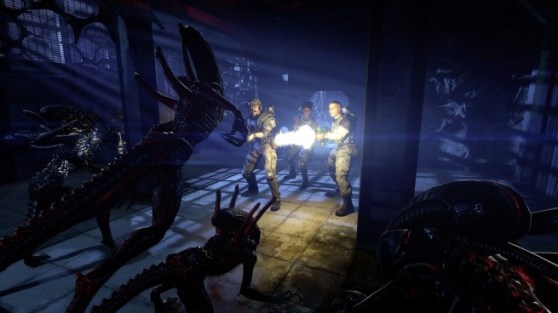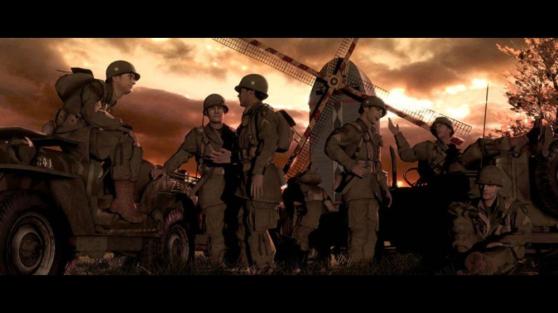GamesBeat: The financial burden or expectation of these triple-A games has very notably shifted a lot of franchises towards the Call of Duty demographic. A perfect example that came out recently is Dead Space 3. That’s one specific example, but there are quite a few more. At a very high, top level, it seems to be like executives are turning to each other and saying, “We need to emulate what’s popular.” Then the creative side is caught in that tug-of-war.
Pitchford: I don’t know that it’s really about emulating what’s popular. I think the real situation is: You have a brand. It has credibility. It’s earned an audience. When you’re going to follow it up, you think to yourselves, “What can we do? We can do anything. What do we want to set for ourselves as goals? Do we want to reach more people? Or do we want to please the same number of people in the same way? Do we want to reach more people or not?” That’s a question. Then, usually, the answer is, “Oh, yeah, we’d love to grow the brand.” Nobody says, “You know want? I want to keep the brand the same.” More people should say that, but not many do. I’ll give you a personal example about that in a moment, if you’re interested.
GamesBeat: Sure.
Pitchford: No one says, “We really want to shrink the brand, actually. Let’s reach fewer people.” No one says that. Usually it’s, “I want to reach more people.” Then they think, “How do we do that?” They look at, “What was our limiting factor? What keeps us from reaching more people? Was it the marketing? Was it the positioning? Was it the design? Was it a component of the premise or the promise of the game? Was it the story? Was it the style? Or was it the actual gameplay?” They ask themselves these questions. The most introspective and self-critical people I know in this industry are people in the craft, people that make things.
I know how I feel as a programmer and as a designer. I’m in this constant battle with myself. I call it the artist’s dilemma. We can imagine something so perfect and so beautiful that we’ll never realize. All artists deal with this. I don’t care if you’re painting the Mona Lisa. The thing that is in the mind of the artist is way better than what is possible with the actual material and the actual labors of our hands. We’re always going to fall short. But those of us that are driven to get better, we use that experience to want to get better. We’re very introspective people. I imagine this team, talking about Dead Space 3… Again, I have not played Dead Space 3 yet. I look forward to it. But I imagine this team thinking to itself, “We do want to reach more people. How do we do that? We can do better. Where can we do this? We’re not going to blame it on marketing…”
And I’m not suggesting that there’s any blame to lay. We’re not going to assume that gains can be earned by other people’s responsibilities. As a craftsman, I’m going to assume that I have to gain it myself through the decisions I make and the work that I do. You can go bigger, faster, harder. That’s a fine strategy. But it’s hard to create precipitous results from that. You can get incremental… “Oh, if I go faster, better, harder, I might increase by five or 10 percent.” But a lot of the dreaming goes more like, “What if we could double our audience?” If you’re a first-person game, you know what the ceiling is. Whatever the game that sold the most in our respective genre, that’s the ceiling. Is that a hard ceiling? Can we push it even further? You start asking yourself these questions. “We’ve got a 22-million-unit ceiling for Call of Duty. Is that a hard ceiling? Where’s my ceiling? How do I move that up a little bit?” You start thinking about your design and questioning your design. You make decisions and changes. This can sometimes do the job.
But we have some other things going on when we have a brand. That is, we have the hopes and dreams of the customers that have been with us before. What happens is … I’m gonna use the bear hug. Imagine we’ve got these customers. We’ve got these little guys that loved us when we made Dead Space and Dead Space 2. We’re thinking, “There’s all these other people out there we haven’t reached. This group is great and we love them, but there’s all these … what do I do?” I can maybe take one of these kinds of strategies [makes a tight bear-hug squeeze]. Or I can maybe bearhug in close and do a wider sweep in. You can go like … [opens his arms as wide as he can] you’re basically letting go of everything so you can reach out and pull it all in. Sometimes people try to do this.
Every time you open your arms just a bit, release that just a bit, there’s a risk that people will seep out. To whatever extent I was a lover of Dead Space one or 2, and I’m playing Dead Space 3, and what I wished for because of my prior expectations isn’t being delivered, I might have feelings about that if I’m an existing customer. But if I’m a new customer, I’m starting fresh. We’re still calling these things one, two, three, four … it’s this weird problem. I was in it.
A couple of years ago at E3, we announced a game called Brothers in Arms: Furious 4. Before that moment, when we were working on the game, we started playing with some game mechanics — we were getting very creative. By the way, we didn’t … the design iteration wasn’t the same problem that I was just speaking to earlier. Game designers just want to explore and try new things. We’re apt to do that because we get bored of the stuff we’ve already done. It progressed to this state where the core loop and some of the things that were going on weren’t perfectly compatible with what we remember from a very different Brothers in Arms game. Some people said it was like a Quentin Tarantino kind of action thing, not the Saving Private Ryan approach. It was more like the Inglourious Basterds kind of approach, just in tone. That’s a style point of view.
From a gameplay point of view, we were all-in for co-op. We loved all these shared-experience kinds of levels we were reaching with our experience making the Borderlands games. We were exploring that and playing with that in that space. We were backing off of the puzzle space of squad combat and using fire and maneuver. We were backing off of that and getting towards this more action-oriented, shared experience, pace-driven kind of thing. From a design point of view, there were some radical iterations there. It got to a point where when we announced it … most critics have to consume a lot of stuff. They don’t love the one thing. Most of the critics looked at it and thought, “Wow, that looks really fun.” Our most hardcore, loyal Brothers in Arms fans were like, “Fuck that. That is not fucking Brothers in Arms. What the fuck are you doing? Burn that fucking thing to the ground. I hate that thing.”
They didn’t even want to parse it for what it was, because what it represented to them was the destruction of the thing that they cared about. It wasn’t the thing that they cared about, yet it was named after the thing that they cared about. And they’re right. They were right. So we went to E3. We had a good time. We felt it was a good show for the game. But what I let happen there was … I said, “Look, you guys are cooking. Unhinge yourself from Brothers in Arms and just cook. You’re going in awesome places. Just unhinge yourself from Brothers in Arms.” It was, I think, about six months or so… A while back I said, “Hey, the next time people see what that is, it’s going to be a new brand. It’s not going to be a Brothers in Arms game. You might not even recognize it.” The people that are watching closely, they’ll see the DNA there. But it’s iterating to a whole new place.
Meanwhile, we know what Brothers in Arms is. We love it and we will do something there. I haven’t announced anything yet, but I had to acknowledge that I was falling into that trap. Or our studio was falling into it. There wasn’t even a mandate. It wasn’t like there was a suit saying, “DO THIS.” I wasn’t directing it. This was just designers wishing to try new things and push new boundaries. But they started from, “Hey, we’re going to make another Brothers in Arms game.” We were able to recognize that and say, “The best game that that can be will be even better if it just unhinges itself from Brothers in Arms.” Meanwhile, Brothers in Arms is awesome! We should make a Brothers in Arms game and we should commit to what it’s supposed to be, instead of trying to turn it into something else.
Take-Two did their earnings announcement, revealing that Borderlands 2 has sold over six million units, which is awesome. Maybe the ceiling for Brothers in Arms is like three or four million units. That’s cool. I can be very profitable with three or four million units. There’s a budget that we can do amazing things with that is a very intelligent budget given those kinds of results. And that’s fine. I don’t need to worry about, “How the hell am I gonna get 20? Let’s spend like we’re gonna have 20, even though we have no idea if we’re going to get there. I’m gonna disappoint people who want it to be what it is and I’ll risk spending a lot more than I make.” That’s a bad decision. The good decision is, “Let’s let that be what it’s supposed to be and make a sensible and disciplined decision about what to invest in it, based on expected results. Then, if we’re having fun in this other direction and there’s value we’re creating there, we love creating new things.”
We’re not afraid to take risks. I mean, look at Borderlands. We’re not afraid of trying … let’s just go there and we’ll figure out a way to create value out of that too. I was really proud of us as a studio when we identified that and we figured that out. We made that tough call. I’m not going to lie. There was a tremendous amount of tension it created with our publishing partners on that. But we resolved that tension and everything is fine. I know that if we weren’t a strong independent … if we weren’t in a spot where we didn’t need any single thing … a lot of these guys are so dependent on a thing, they can’t risk damaging it. We’re in a spot where we have multiple brands. We’re strong enough to where I don’t need any single thing. I can take the risks. “I think this is what needs to be done with it, and it might break it if we go there, but this is what we have to do. If it breaks that’s probably a better result than going down the wrong path.” So yeah. Does any of that make sense?


